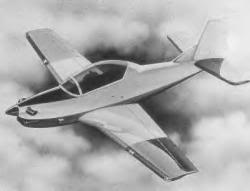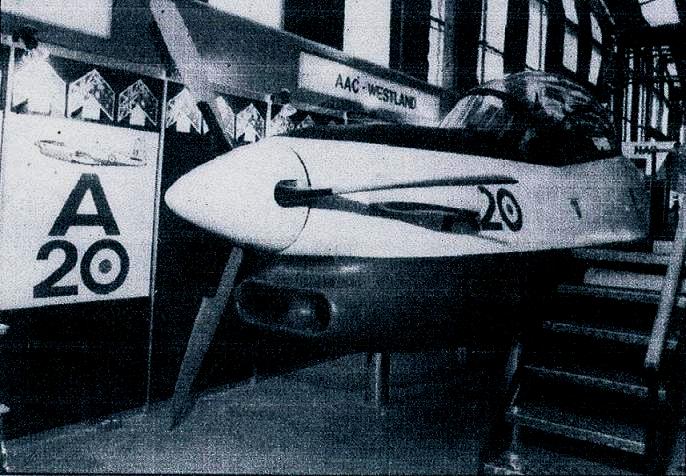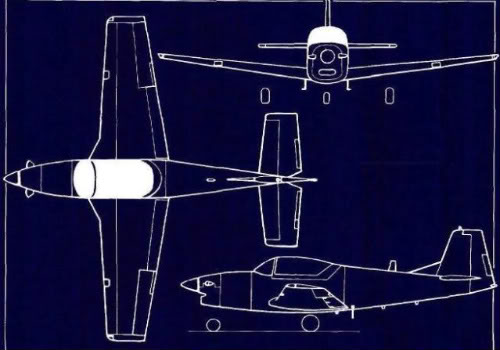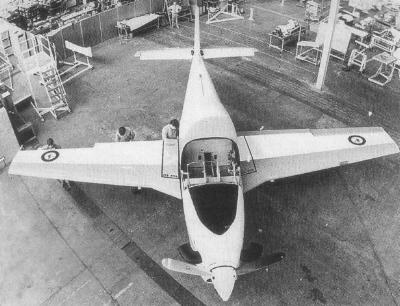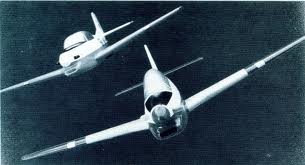
ADF-SERIALS
Australian
& New Zealand Military Aircraft Serials & History
RAAF Australian Aircraft Consortium A23 Wamira (A10 & A20)
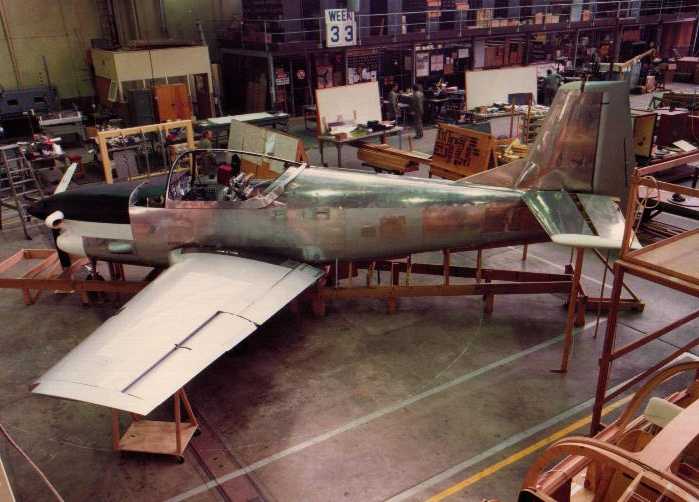
During 1981, an entity known as the Australian Aircraft Consortium (AAC) was formed with the intent of offering and producing a new training aircraft for the RAAF, with its members being the three major Australian based aircraft manufacturers of the time, namely:
- Commonwealth Aircraft Corporation (CAC),
- Government Aircraft Factories (GAF), and
- Hawker de Havilland (HdH).
The RAAF had expressed an intention to buy 69 aircraft and specified a requirement for a turboprop trainer of broadly conventional tricycle undercarriage low-wing layout, to be powered by a Pratt & Whitney Canada PT6A-25C engine. In accordance with the RAAF training doctrine of the time, its two seats were to be in a side-by-side configuration. The RAAF had also specified that the type be fully aerobatic, capable of cross-country navigation and weapons training, have a 200 kt cruising speed at sea level, and a minimum service life of 20 years and an airframe life of 8,000 flying hours.
AAC signed a design and development contract with the Commonwealth in June 1982 and began work to design and produce an aircraft to meet the RAAF's criteria under the designation A10. CAC also allotted the the internal CA34 designation for its part in the venture.
To make the design more marketable to other potential operators beyond Australia, a tandem seating arrangement version was also designed and known as the A20 version of the Wamira and a Memorandum of Understanding (MoU) was signed with Westland Aircraft to establish a joint venture to market the A20 version in Europe.
The A20 Wamira was entered in the competition to replace the Royal Air Force (RAF) fleet of BAC Jet Provosts. An engineering mockup (EMU) was produced in Australia consisting of a fuselage from the fin fillet forward and also included stub wings. While the EMU was primarily made from wood & alloy it also utilised some genuine components such as the ejection seats, control columns, rudder pedals and other items. The EMU was shipped to the UK and was featured on the Westland stand at the 1984 Farnborough Airshow.
The Wamira was not in a strong competitive situation as it was still in the design stage whereas the all of the other contenders (Pilatus PC-9, Short/Embraer Tucano & NDN Firecracker) had already flown and apart from the Firecracker, were in production for clients. The RAF competition was ultimately won by Short Bothers with their licence produced version of the Embraer EMB-312 Tucano. This loss contributed to placing the entire whole Wamira project in doubt. Other factors included delays in completing the Wamira prototype and serious project cost overruns. A Commonwealth Auditor-General report had also found that the Wamira project cost was likely to be more than double that originally estimated and budgeted and likely to climb to around AUD$79 million if further action was not taken.
In July 1985 it was announced that the RAAF trainer requirement was to be subject to a competitive selection process. The contenders were announced as the Short Tucano and Pilatus PC-7and PC-9 (all of which had tandem seating arrangements) as well as the side-by-side seating Wamira . In the same month CAC was absorbed by HdH, meaning that HdH now had a two-thirds share in AAC. It subsequently became sole owner of the Wamira project when it bought out GAF's share of the venture shortly after.
This completive process was remarkably short, as on 16 December 1985 the Pilatus PC-9 was announced as the winner of the competition and the Wamira project was immediately cancelled. The original AAC consortium partners later becoming jointly responsible for license-production of the PC-9a in Australia.
Editor's note: I have a several personal connections with this event/date as I was working in the Department of Defence and processed the final payment to AAC which wound everything up that day. My father-in-law worked at GAF at the time and it also happened to be his birthday. We met after work as usual for our drive home and I think that we were both a bit shocked by the announcement that the Wamira was being canned and that the RAAF was going to be picking up the PC-9a instead! The irony of the A23 allotment was not also not lost on me as the Series 2 allotment of the A23 prefix was the Woomera - a similar sounding aboriginal language word to Wamira with a different spelling and no coincidence at all! A colleague at ARL from the time told me that they had an aboriginal language specialist at the labs who had some influence on the selection of that name many other indigenous names in ADF programs. Brendan Cowan
This was not quite the end of the Wamira story as an attempt was made to resurrect the the type from the ashes fifteen years later - quite literally as a Phoenix!.
Formed as an Australian general aviation export business, Endeavour Aerospace acquired the Wamira design and the associated rights, drawings and design records from the Australian Government in 2000 and they renamed the aircraft as the Phoenix. Endeavour was hoping to sell the type as a training, recreation, sports and utility aircraft with particular emphasis on US private market. Financial backing was being obtained in 2002-03, but no further public announcements were made and the company was voluntarily de-registered on Tuesday 15th March 2016.
So what happened to the prototype and engineering mockups?
The A10 side by side prototype and Engineering Mock Up (EMU) were held at the RAAF Museum Point Cook, while the A-20 EMU resided at the Westland Helicopters factory at Weston until the site was closed 1986. The A-20 mock-up was returned to Australia in 2012 and held in storage by the Australian Aircraft Restoration Group (AARG) in Melbourne pending restoration.
On the 19th of August 2019, the A10 Wamira prototype and the front fuselage of the A10 Engineering Mock up, plus a cache of spares, tooling and documentation were transferred to the AARG and delivered to their museum at Moorabbin. This brought a great deal of the remaining artifacts of the program together in one place. In return, the AARG Lincoln (RF342) was exchanged for restoration by the RAAF History and Heritage at Amberley.
| Serial | Type | C/N | Airframe History |
| Nil | A10 Wamira (Prototype) |
01 | 1982-1985 Built by AAC at Fishermans Bend
as the A10 Prototype, 16/12/1985 A10 Wamira Prototype - 90% Complete at time of project cancellation. Transferred to RAAF Museum Point Cook for storage. 19/08/2019 Delivered to AARG, Moorabbin. |
| Nil | A10 Wamira (Static test) |
02 | 1982-1985 Built by AAC at Fishermans Bend
as the A10 Static Test Specimen, 16/12/1985 Project cancelled. |
| Nil | A10 Wamira EMU |
? | 1982-1985 Built by AAC at Fishermans
Bend as the A10 Engineering Mock Up (EMU), 16/12/1985 Project cancelled, Transferred to RAAF Museum Point Cook for storage, 19/08/2019 Delivered to AARG, Moorabbin. |
| Nil | A20 Wamira EMU | ? | 1983-1984 Built by AAC at Fishermans Bend
as the A20 Engineering Mock Up (EMU), Early 1984 Shipped to Westland Aircraft, UK, July 1984 Displayed at 1984 Farnborough Airshow, 16/12/1985 Project cancelled, 1984-1986 Held in storage by Westland Aircraft at Weston factory, 1986-2012 Stored and deteriorated in the UK, 2012 Acquired by AARG and returned to Australia, Current Stored by AARG in Melbourne pending restoration and display. |




